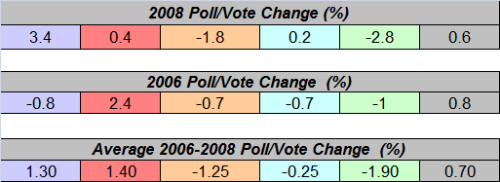 Short answer: Absolutely, yes. She has a very good chance.
Short answer: Absolutely, yes. She has a very good chance.
Long answer: Still probably yes. However, if she runs her campaign the way she ran her candidacy “announcement”, then she could be in serious trouble.
Elizabeth May seems to have definitively chosen British Columbia’s Saanich—Gulf Islands riding as her choice in which to run in the next federal election. I have to admit that I am intrigued by May’s decision to run there. The circumstances around this move have been less than ideal for May and the Greens, however I don’t think it’s a bad move (though the data clearly shows it probably wasn’t the best move if you take “best” to mean “highest chances of success”). This move possibly could very well end up paying off for the Greens (more on that later), however the manner in which May has done this has been amateur hour at the comedy club.
First the downside for May and the Greens, then I’ll end on an upbeat note.
In speaking to media earlier this month, May stated that there was still a variety of issues not yet resolved within the party regarding her candidacy in Saanich—Gulf Islands. However, in the same breath, she said that Saanich—Gulf Islands was her choice for where to run.
I guarantee you May’s political operatives cringed when she gave that quotation. This raises several questions all of which reflect poorly on May:
- If she comes out and states that this riding is her choice, then why is the Green Party senior organization still “considering” it?
- Has a rift broken out between Elizabeth May and the Green Party senior organization?
- Why is Elizabeth May announcing this while a process to decide which riding to select is still ongoing? Wouldn’t this announcement render such a process moot?
Furthermore, the Greens already have an announced candidate in the riding who hails from the left flank of the party and does not appear willing to step down. May’s party is one of the most ideologically diverse in the country, and in such situations, it is generally important to keep all wings of the party happy. May’s hasty move now risks stoking the ire of the left wing of the Green Party which, when combined with the criticism May’s been receiving from the right flank of her party, makes finding that winning dynamic that more difficult (though not impossible).
May needs to learn that there’s a reason why serious politicians don’t give a solid answer to a question when the decision is not yet firm and all of the ramifications have not been fully itemized. This is a pretty remedial lesson in political circles and it usually comes around the same time that political operatives learn that decisions don’t get made in committees and that you never ask a question in front of a microphone to which you do not already know the answer.
Moving on to the good news for May and the Greens:
Despite all of this, the data still show that May has at least a decent chance of snatching this riding from the clutches of the Tories.
Greg Morrow over at Democratic Space has a post analysing whether Elizabeth May can beat Gary Lunn in Saanich—Gulf Islands. Greg concludes that May doesn’t have a chance against Lunn and that even the best possible outcomes have her loosing by several thousand votes.
I think Greg is a fantastic political analyst and I have a great deal of respect for him. However I’m going to have to respectfully disagree with his conclusion in this matter.
So far May has run in two elections (London North Centre in a 2006 by-election and Central Nova in 2008).
In the 2006 general election in London North Centre, the election results were as follows:

When May ran in the by-election in London North Centre, the results were as follows:

As you can see, May improved the Greens’ showing by 20.3%.
As for Central Nova, in the 2006 general election, the results were:

When May ran in 2008, the results were:

As you can see, May improved the Greens’ showing this time by 30.5%.
From this data, we can extrapolate a few things. When Elizabeth May runs in a riding, on average the following happens:
- The Greens go up by 25.4%
- The Conservatives go down by 1.3%
- The Liberals go down by 5.3%
- The New Democrats go down by 12.8%
However, the overall Green vote increased in Atlantic Canada by just shy of 4% between 2006 and 2008. So roughly 4% of Elizabeth May’s increase wasn’t due to her presence but rather was due to an overall rise in Green Party fortunes in that region. Because of this, we need to reduce her number (25.4%) by roughly 4% to fully take into account just the amount that Elizabeth May’s presence increases the Green vote in a riding isolated from other factors. Doing this, we end up with the following data:
- The Greens go up by 21.4%
- The Conservatives go down by 1.3%
- The Liberals go down by 5.3%
- The New Democrats go down by 12.8%
Now, we need to apply these numbers to last election’s results in Saanich—Gulf Islands.
But before we do, there is one problem. Last election in Saanich—Gulf Islands, the NDP candidate had to drop out after his skinny dipping incident came to light. We know that whenever an NDP candidate drops out, it has an effect not just on the NDP’s total numbers but also on the other progressive parties’ numbers as the disaffected New Democrats “park” their vote elsewhere. Thus, assuming that next time the NDP candidate in this riding is unlikely to become disgraced again, I will be using the 2008 election results for the Conservatives and the 2006 numbers for the Liberals, NDP and Greens. (Note that, if anything, this will provide a slight bias in favour of the Conservatives as their vote total was slightly higher in 2008 than in 2006).
So we have this as our base:

Applying the “Elizabeth May change numbers” to this base projection, we get:

Now that’s still a win for the Conservatives (and a safe one at that).
But…
Remember that we earlier stripped the change in the Green Party’s vote between 2006 and 2008 out of Elizabeth’s May’s numbers. So now we have to reintroduce the change in the Green Party’s (and the other parties’) polling numbers but this time we have to do so looking at the region of British Columbia rather than Atlantic Canada.
It turns out that the Greens have an overall more favourable climate in BC than they do in Atlantic Canada and this is important.
Beginning from the “raw vote projection” just calculated above, we now will apply the changes to each party in order to obtain our final projections.

Now, I do not vouch for the exact vote totals appearing in these final two columns. However, as a rough predictor of how probable an Elizabeth May victory is, I think this is a strong indicator that it is entirely possible.
*UPDATE:
Greg Morrow below noted that I forgot to take into account the fact of the change in each party’s support between the polling data and the actual vote results. I thank Greg for pointing this out because this is an important revelation considering that the Conservatives tend to do better in elections than in polls whereas the Greens tend to do much worse.

So, applying these changes to the above above projections, we get the following “final final” projections (as best as we can given the sparse data available):


So we have a much tighter race in the Arithmetic projections here. Furthermore, the race could definitely slide back into Gary Lunn’s hands if the Conservatives can retain their 2008 vote/poll discrepancy rather than what they witnessed in 2006. The race could also slide back into Gary Lunn’s hands if the Greens get closer to their 2008 vote/poll discrepancy rather than what they witnessed in 2006. However, my theory is that the vote/poll discrepancy for the progressive parties witnessed in 2008 was partly exaccerbated by the fact that the vote was held so early in the academic school year which meant that all young 1st year university students studying in a different town might not have yet received the two pieces of mail necessary to vote which thus put the hammer to the most important progressive demographic. This year, it’s looking like the vote will be in late October at the earliest (rather than early-to-mid October) which might help out the youth vote and make the discrepancy closer to that witnessed in 2006. I could, of course, be totally wrong about this, but that is my feeling talking with staffers on Parliament Hill from multiple parties.
I certainly wouldn’t want to wager a great sum of money on it, but I would argue that this analysis still nevertheless establishes that Elizabeth May does have at least a fighting chance of securing the riding.
 Very few things Stephen Harper has done while in power have genuinely scared me.
Very few things Stephen Harper has done while in power have genuinely scared me.
















Recent Comments